Inexpensive and reliable way of heating! Gas heating: operating principle, pros and cons
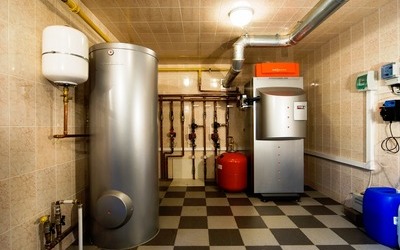
Gas boiler as a heat source used everywhere and is considered the optimal means of heating a room.
Natural gas - the most accessible and inexpensive energy source. That is why gas heating is so popular.
Even if there is no possibility of connecting to the main line, it is possible to consider alternative home gasification projects (gas holder, gas cylinders).
Content
Gas heating system
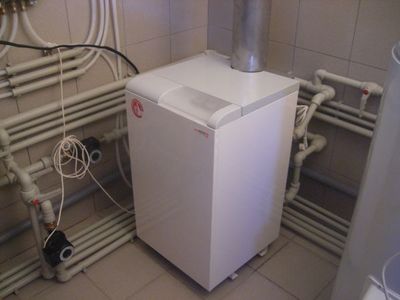
The use of gas boilers for heating premises is the most common way of heating private houses. When heating a house with gas no waste is generated: no dust, no dirt.
There are floor-standing and wall-mounted boilers. They have the following characteristics:
- Floor standing appliances have a significant mass due to the cast iron heat exchangers installed in them. They require a separate room. They work up to 50 years due to the anti-corrosion properties of cast iron.
- Wall mounted gas boilers can be installed in the kitchen or in the hallways. The heat exchangers in them are made of steel, so they are lighter and have a rather presentable appearance, the devices fit well into the home interior. They serve from 15 to 20 years old, have a lower cost.
There are two types boilers: single-circuit, used exclusively for heating, and double-circuit, which also heat water.
The devices are classified and by combustion chamber type. It happens:
- open — consumes air from the room (additional ventilation is therefore required);
- closed — takes in the street air.
Operating principle, diagram
The design of the heating system using a gas boiler is standard. It contains:
- heat source;
- water as a coolant;
- circulation pump;
- pipeline;
- expansion tank;
- heating elements;
- shut-off and control valves.
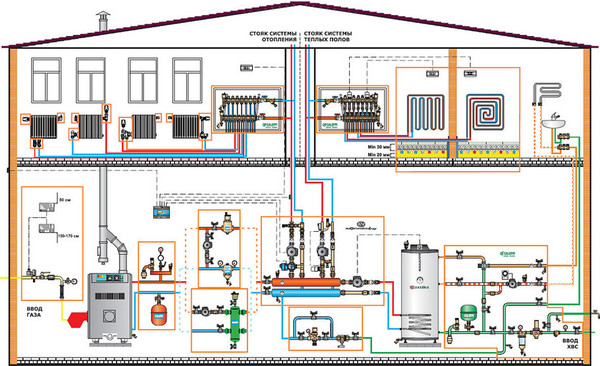
Photo 1. Heating scheme of a private house using a gas boiler. Radiators and warm floors are used for heating.
The market offers many models gas boilers, but In principle, they are practically no different from each other. Using internal sensors and thermostats, the controller supplies natural gas to the combustion chamber. In the heat exchanger, the water is heated to the required temperature and is pumped into the heating circuit by a pump. Heating will continue until the required temperature is reached.
In the future, the automation will maintain the temperature at a given level, without requiring human control. Double-circuit boilers imply the use of water from the heat exchanger for household needs, but fluid collection to maintain balance, somewhat limited and depends on the size and power of the unit. Some gas boilers are used in underfloor heating systems and even for heating swimming pools and greenhouses.
Pros and cons
Gas boilers are the most economical heat sources, but They have other positive aspects too:
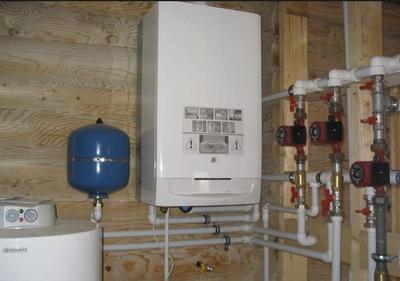
- Can heat large rooms.
- Have a high efficiency factor (80-95%).
- They quickly warm up rooms.
- There is no need to monitor the boiler, everything is maximally automated.
- If for any reason the burner flame goes out, its re-ignition will work.
- Easy to operate and maintain.
- Have a long service life (from 15 years old).
- Allows you to control the temperature in your home down to a degree.
- The use of such boilers is safe.
- The devices are compact.
Cons gas boilers:
- It is not economically feasible to place these devices in houses with an area of less than 100 m2, their use in such conditions is considered extremely dangerous.
- Installation of gas boiler equipment requires the preparation of the necessary documentation (it is necessary to obtain permission from Gaztekhnadzor).
- It is necessary to install a chimney to remove exhaust gases.
- The room in which the boiler is installed must have a separate exit to the street and forced air ventilation (especially for boilers with an open combustion chamber).
- When the gas pressure is low or the burner fails, the efficiency of the device drops sharply.
- It is necessary to install expensive automation to ensure safety control.
The most profitable option is to install a gas boiler. in a house connected to the main gas supply network. From the central pipe, a supply line is made to the house directly to the heating equipment, which allows you to completely forget about the issue of heating the premises, delivery of energy carrier and operating costs. These heating systems comply with all modern environmental standards.
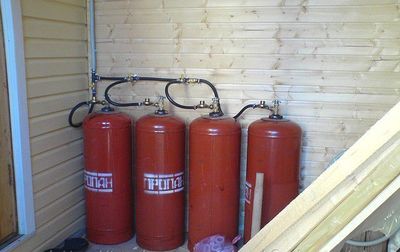
The autonomous gas heating system includes gas holder or gas cylindersIt is advisable to plan and take into account the installation of a gas tank on a site during construction.
This will allow the gas pipeline to be laid underground to the boiler room and kitchen. The use of cylinders is practically unlimited.
When calculating the efficiency of heating private homes with liquefied gas, it is necessary to take into account that one 50 liter cylinder accommodates 35-42 liters of gas. Heating costs 100 sq. m. per day for any boiler is equal 15 liters It is also necessary to remember that the cylinders are filled once a week. Heating the house with gas cylinders can be considered profitable when the following conditions are met:
- The area of the house is smaller 100 sq. m.
- The building has good insulation.
- The gas boiler is a backup.
- In the future, gasification of the settlement is planned.
AGV heating: what is it
Even in Soviet times, heating systems used autonomous gas water heaters. These installations are the simplest of all those used in heating systems using natural gas. Advantages of AGV installations:
- the simplest design, ensuring ease of control;
- low price;
- compactness;
- independence from electricity;
- reliability.

Photo 2. Description of the device of an autonomous gas water heater. The arrows indicate the components of the device.
The negative aspects of the units are: short service life, frequent automatic failures, condensation formation.
The devices remain popular because of the cheapness And constant growth of electricity tariffs.
How to make a heating system with your own hands
In a private house, you can install a gas heating system with your own hands. This requires:
- perform the necessary thermal and hydraulic calculations;
- draw up a working project with a gas heating scheme;
- purchase materials and equipment;
- carry out installation;
- test the heating system under high pressure;
- put into operation.
When developing a gas heating system, the following are determined: circulation of coolant: they decide whether she will natural or forced. An important point is also the choice of a single-pipe or two-pipe heating circuit layout.
After choosing the heating scheme and piping layout you can calculate the required power boiler, circulation pump and radiators, and also decide on the diameter of the pipes, their quantity and sizes.
Types of boilers
Having decided on the capacity of the gas boiler, proceed to choosing the device.
| Classification of gas boilers | ||||
| By the number of contours | By type of firebox | By ignition method | By installation type | By type of power modulation |
| Single-circuit | Closed | Piezo ignition | Wall mounted | Single stage |
| Double-circuit | Open | Electronic ignition | Floor standing | Two-stage |
Regardless of the type of boiler, the owner's main task is to ensure the efficient operation of the most important communication system of the house with minimal financial and labor costs.
Installation of equipment
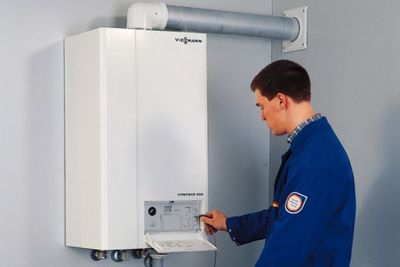
Installation of the heating system begins with the installation of the boiler.
Necessary tools for installation of the heating system:
- roulette;
- hammer drill;
- level;
- flaring machine;
- gas, adjustable and regular wrenches;
- screwdriver or screwdrivers.
For fastening use 4 self-tapping screws with diameter 6-7 mm. The accuracy of the installation is checked using a level. After that, the connection to the water supply is made using a coarse water filter. Ball valves are installed. The chimney is connected.
Attention! Connect the boiler to the gas pipeline Only a specialist should.
After installing the gas boiler, proceed to laying the pipeline according to the diagram. There are three types of pipes, used in heating systems:
- metal;
- metal-plastic;
- polymer.
For a private home heating system, it is best suited plastic pipeline. It is not afraid of temperature and pressure changes. Its installation is carried out using a special kit that allows you to reliably solder the system elements.
Radiators are selected taking into account the required power. There are batteries made of different materials on the market:
- steel;
- cast iron;
- aluminum;
- bimetallic.
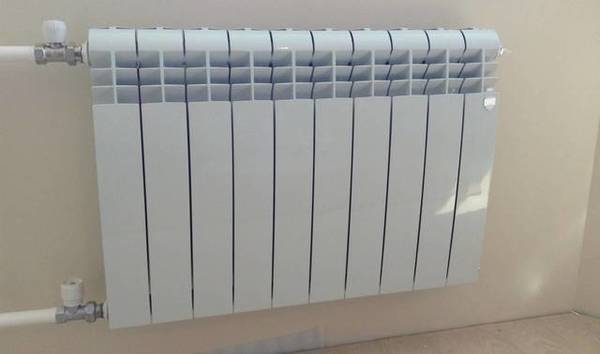
Photo 3. Bimetallic radiator. Such devices are often used in gas heating systems.
During installation a level should be used to ensure the radiators are installed correctlyAfter installation of all elements of the gas heating system, pressure testing of the pipes is mandatory.
How to calculate average gas consumption
The main indicator influencing gas consumption during the heating period is the average daily outdoor temperature. Calculations are used to determine the volume of gas consumed under specific conditions. The average consumption is taken as 50 W/m2 in 1 hour. From this it is calculated that for heating a house with an area 100 sq. m will be required 0.54 m3/h natural gas. Liquefied gas for heating a building of the same size is needed 0.78 l/h or 561 l per month (and this is about 14 cylinders, which is very expensive).
Which is better: gas or electric heating, their comparison
When choosing a type of heating for a private home, the following main criteria are taken into account: area of the house, availability of the main gas pipeline, price of energy in a specific region.
It is profitable to install main gas heating only in houses with an area from 100 sq. m. In other cases, it is more appropriate to use autonomous gas heating or electric heating. The choice depends on the available resources and energy prices.
Useful video
Watch the video, which tells how to choose a gas boiler for a heating system, what characteristics to pay attention to.
Choosing gas heating is a serious decision!
When choosing a gas boiler, an economical, safe and reliable means of heating a building, It is necessary to consider all the pros and cons, and also make calculations. After this, you can make a purchase of boiler equipment and heating system elements. If you have the slightest doubt about choosing such an important unit that affects the quality of life, contact specialists.








